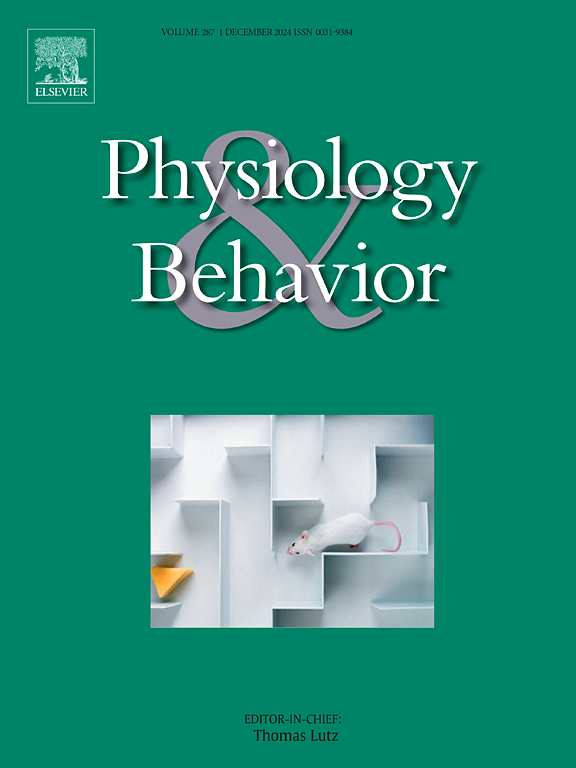倾听你的胃:胃生物反馈训练对内感受、饮食行为和饮食失调症状的影响。
IF 2.5
3区 医学
Q2 BEHAVIORAL SCIENCES
引用次数: 0
摘要
胃内感受是对来自胃的信号的感知,在调节饥饿、饱腹感和饱腹感方面起着核心作用,并与饮食行为和饮食失调(EDs)的症状密切相关。胃运动已被确定为饥饿和饱腹感的关键介质,在ed患者中观察到胃节律的改变。因此,通过靶向胃节律来增强胃内感受可能是一种很有前途的干预策略。本研究检测了使用虚拟现实(VR)或二维(2D)显示器进行的基于胃电图(EGG)的新型胃生物反馈训练与对照条件的效果。以健康大学生为主的样本(N = 94)在两周内参加了四次生物反馈会议。我们评估了心脏、胃和一般的内感受,以及自我报告的饮食行为(情绪性、外源性、克制性和直觉性饮食)和ED症状。我们期望生物反馈训练能够改善内感受、饮食行为和减少ED症状,其中VR组效果最强,其次是2D组,而对照组效果最弱。线性混合模型分析显示,二维条件是最有效的,在胃和一般内感受(特别是饱腹感和饱腹感,以及身体倾听)以及直觉进食方面表现出最大的改善。这些研究结果表明,二维胃生物反馈可能是一种有效和容易获得的内感受训练方法,可以在家庭环境中应用。未来的研究应探讨其在急症人群中的临床应用。本文章由计算机程序翻译,如有差异,请以英文原文为准。
Listening to your stomach: Effects of gastric biofeedback training on interoception, eating behavior and eating disorder symptoms
Gastric interoception, the sensing of signals from the stomach, plays a central role in regulating hunger, satiety, and fullness and is closely linked to eating behaviors and symptoms of eating disorders (EDs). Gastric motility has been identified as a key mediator of hunger and satiety, with altered gastric rhythms being observed in individuals with EDs. Enhancing gastric interoception by targeting gastric rhythms may therefore offer a promising intervention strategy. This study examined the effects of a novel electrogastrography (EGG)-based gastric biofeedback training delivered using virtual reality (VR) or a two-dimensional (2D) display, compared with a control condition. A sample of predominantly healthy university students (N = 94) participated in four biofeedback sessions over two weeks. We assessed cardiac, gastric, and general interoception, along with self-report measures of eating behavior (emotional, external, restrained, and intuitive eating) and ED symptoms. We expected biofeedback training to improve interoception, eating behaviors, and to reduce ED symptoms, with the strongest effects in the VR group, followed by the 2D group, and the weakest effects in the control group. Linear mixed model analyses revealed that the 2D condition was the most effective, showing the greatest improvements in gastric and general interoception (specifically satiation and fullness sensing, and body listening), as well as intuitive eating. These findings suggest that 2D gastric biofeedback may be an effective and accessible approach to interoception training which can potentially be applied in home settings. Future research should explore its clinical utility in populations with EDs.
求助全文
通过发布文献求助,成功后即可免费获取论文全文。
去求助
来源期刊

Physiology & Behavior
医学-行为科学
CiteScore
5.70
自引率
3.40%
发文量
274
审稿时长
47 days
期刊介绍:
Physiology & Behavior is aimed at the causal physiological mechanisms of behavior and its modulation by environmental factors. The journal invites original reports in the broad area of behavioral and cognitive neuroscience, in which at least one variable is physiological and the primary emphasis and theoretical context are behavioral. The range of subjects includes behavioral neuroendocrinology, psychoneuroimmunology, learning and memory, ingestion, social behavior, and studies related to the mechanisms of psychopathology. Contemporary reviews and theoretical articles are welcomed and the Editors invite such proposals from interested authors.
 求助内容:
求助内容: 应助结果提醒方式:
应助结果提醒方式:


